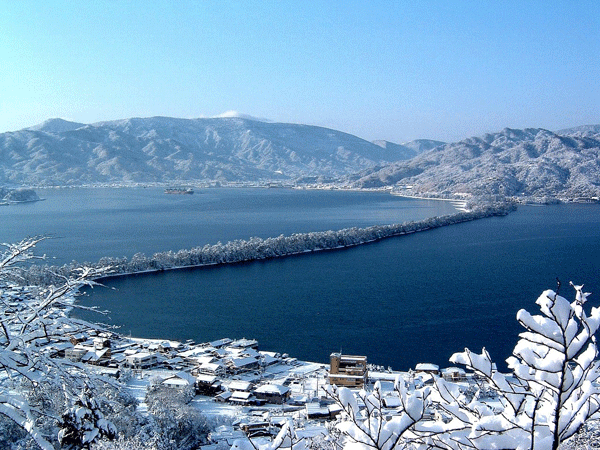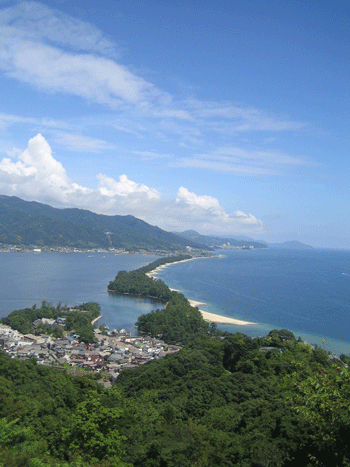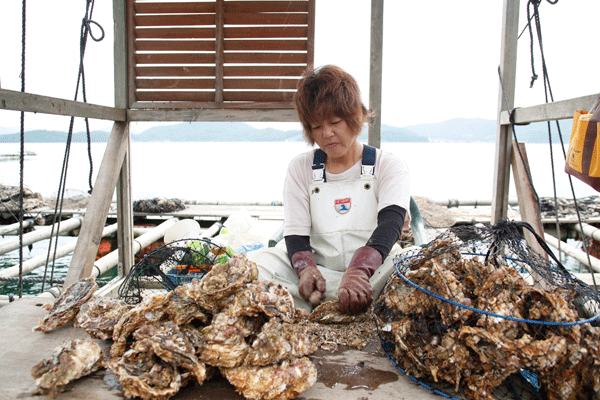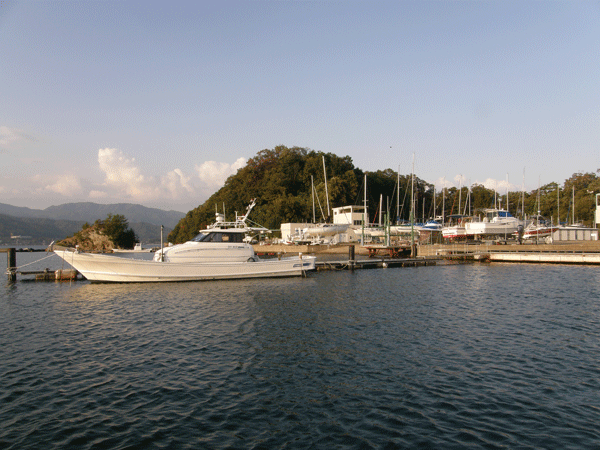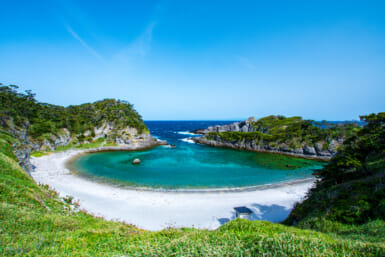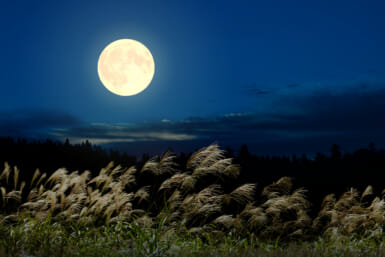In the region of Tango, in the northern part of Kyoto prefecture, you will find a coastline that is home to some of Honshu’s most outstanding scenery.
The bridge of heaven, Amanohashidate (pictured above) is the two-mile sand bar that straddles mountains, separating the Miatsu bay, on the Japan Sea, from the Asoumi lagoon. According to legend, a ladder, named Amanoukikashi, was placed so that the male God, Izanagi, could go back and forth between the heavens and the beach of Kushibi, where he liked to live. He was, though, a careless god and fell asleep, the ladder crashing to earth and forming the bar we can see today.
Though most famously considered one of Japan’s top views – it does indeed deserve its place alongside that from Mt. Hakodate and of Kobe by night – it is for us by walking or cycling along the pine-covered area that this trip becomes an unforgettable experience.
The marine landscape and surrounding area has given inspiration to many artists, poets and writers over the years. It is not just mythology but also Heian and Edo period history that have influenced how travellers, particularly those who have grown up in Japan, view the area. The grande dame of classic poetry, Izumi Shikibu, for instance, took inspiration from the views, as did well-known Noh theater author from the Muromachi period, Zeami.
The white sand beaches on the ocean side and lush pine forest that covers the “bridge of heaven” is actually also seen as an inspiration for traditional Japanese garden landscaping.
Amanaohashidate was considered an ideal model during the Heian period, when gardeners established the classic style we are now so familiar with. Many still use a motif of the Tango sand bar as a main feature of their garden, including that of the Katsura imperial villa.
Amanohashidate is also a deeply religious area where, locals say, “deities are at work”. Besides the Chion-Ji and the Nariai-ji Temple, the Motoise Kono-jinja shrine really deserves a visit.
The old shrine, the greatest in Tango, is constructed in the same style as that of the Grand Ise Shrine in Mie prefecture. Umisachihiko is the main deity there and the shrine is deeply related to the sea. The Amabe family of Shinto priests, who serve the shrine on a hereditary basis, are still officiating there with their latest descendent: Yoshinari Amabe.
His family tree, Japan’s oldest, is a national treasure and is kept in Kono with many other cultural properties. Every year, on April 24, the area sees an important festival and regular sword wielding shows are held there.
“Throughout history,” says Yoshinari Amabe, “local citizens have lived in spiritual harmony with nature. Before the Edo period it is believed that they gathered fallen leaves, cut branches for fuel and worked towards reforestation after wind and snow damages.”
Now, as since Meiji times, shore and protection measures have been taken in accordance with national laws and regulations. But citizens have continued to work on environmental protection activities, such as planting Japanese black pine seedlings to minimize pine wilting damage, maintaining the shoreline and giving names to the pine trees as a token of care. After a typhoon caused great damage in 2004, locals set up an executive committee in order to repair Amanohashidate pine forests.
Field to Fork – or is that chopsticks?
The Kyoto prefecture’s northern border, Tango or Kyotango, is also reputed for its agricultural produce. Visiting last month gave me some very pleasant surprises.
The Amanohashidate Winery, for instance, has since 1999 produced very decent wines on the shoreline of the lagoon near Kokubun, Miyazu. We visited impressive nearby caves for a delightful wine tasting (the white Chardonnay was particularly memorable) followed by a gourmet dinner in the annexed restaurant. Here you can enjoy fusion cuisine with a European-Japanese taste.
The nearby orchards and fields are well known for providing high quality fruits and vegetables and the area has gained a reputation for its focus on a sustainable, eco-friendly model. Historically, the region of Tango has played an important role in providing agricultural products to the ancient capital of Japan.
Here, the best kaiseki restaurants of Kyoto do their weekly shopping; the surrounding fields are the starting point for round kamo eggplants, large and sweet tamba chestnuts and Matsutake mushrooms.
Speaking of gastronomical excellence that we discovered during our trip in the region, we have to remember some premium sake brands made here, such as Hakurei. We also learned that a man called Fujisu produces exquisite vinegar in the traditional way from unpolished rice here. He even supplies selected international clients, perhaps his most famous being Joël Robuchon, and also creates a sophisticated vinegar from figs and one from red potatoes that is even reputed to have fat-burning properties.
These exquisite local sakes and special vinegars are used at Shichirin-yaki by Kanemasu Tukasa, a young Japanese chef who lives and works nearby and specializes in a traditional way of cooking local crabs, oysters, yellowtail and winter shads. We found his small but elegant shop was open at random hours at night (but always works during lunch hours) to satisfy his fastidious clientele of local gourmands. We tried a rare delicacy: a red snapper slightly dried and carefully cooked over charcoal.
Another important spot in the Miyazu domain of Tango is the old Mikami family house. The merchant family flourished in Edo times as a brewer, shipping agent a money dealer. The very well preserved elegant mansion later became the refuge of Kinmochi Saionji during the Boshin war, the civil war that erupted in Japan in 1868 and saw the final defeat of the Tokugawa shogunate. Saionji, a prominent statesman, became later prime minister and was a founder of the Ritsumeikan University.
Sun, Sea and Hot Springs
The Tango region is well known for its beaches, such as at Konobichi, and its panoramic views (at Yuhigaura and Tateiwa) and also offers a great variety of hot springs. The Kurhaus Iwataki, for instance, is a modern facility that combines German and Japanese bathing methods. There is also the Yasaka Ashiginu, a structure that stands twenty-six meters above the ground, the Ukawa onsen, outdoor baths of both the mountains and the seas, and the Takao onsen.
This northern area aims to preserve an old and very Japanese industrial tradition. Textile factories in the area produced chirimen, a high quality and delicate piece of silk. This rare material was once a must for the kimonos of the elegant ladies in Tokyo, Osaka and Kyoto but changes in fashion and lifestyle have reduced the Chirimen-futakoshi production to a niche industry.
An old silk factory – dating back to 1935 – has been reconstructed at the Tango-chirimen history museum (317 Iwawa, Yosanocho, Yozagun) where the visitor can find documents and photos related to the industry and an old Hatcho thread-plying machine. Not far from that, stretching out from the Ushigono and Kaya areas is the once famous Chirimen Kaido, the silk district.
Along its main road, built during the Azuchi Momoyama era at the end of the 16th century, you can feel some of the atmosphere of bygone days, hear the clattering sound of weaving and see traces of the many old shops that existed here.
Among the other historical relics of Tango, down in Maizuru city area, is the Kongoin temple, which is known for its beautiful red autumnal leaves. Yukio Mishima described its graceful three-storied pagoda, built in the Heian era, in his novel The Temple of the Golden Pavilion.
The red brick warehouses in Maizuru port area were used to store weapons since the founding of Japanese naval headquarters in 1901. Admiral Heihachiro Togo, the Nelson of the East, commanded this naval base. A few years later he became the hero of Tsushima after destroying a Russian fleet in a celebrated navy battle.
The brick warehouses are now beautifully restored and used for cultural events such as conferences, art exhibitions and concerts. One is devoted to the history of bricks and brick making worldwide. Another former torpedo deposit hosts a permanent exhibition dedicated to the 600,000 Japanese soldiers that were deported by the Soviets to forced labor camps in Siberia and Mongolia after the second world war.
On the hilltops of Gorogatake, overlooking Maizuru Port, an observation tower offers a complete and breathtaking panoramic view of the deeply indented coastline. If you visit on the weekends, as we did, take a mini cruise. From the boat we could appreciate all the aspects of the beautiful coastline and its small fishing villages and also sailed past a Japanese battleship from a nearby naval base that was anchored in the bay.
The Kyoto Maizuru port is in fact undergoing a quay improvement project for large-scale passenger cruise ships. Besides the existing commercial activities of the port and the already active Northwest Pacific Region Cruise (which takes in Otaru in Hokkaido, Fukishi in Toyama and Maizuru in Kansai) it is clear that the local authorities believe in tourism. The new expressway, to be completed 2014, will considerably reduce journey time to and from Kyoto city.
Text by Koko Shinoda
Getting There:
From Kyoto City to Amanohashidate Station, is around 2 hours 30 minutes north, by JR line. To Higashi Maizuru Station it is about 2 hours.

